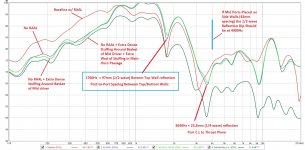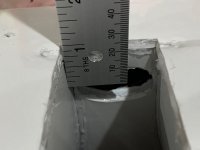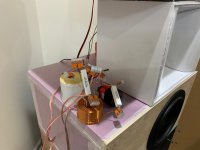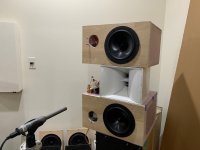Hi!
I did some reading on the subject since this is an interesting topic. Found out that Patrick Bateman hasn't found a way to extend top response to 3k yet with his 10+year journey of point-source horns. For example here Suitable midrange cone, for bandpass mid in Unity horn.
Also, on that same thread few posts before, Barniboy talks his findings about the notch on the midrange response. In your case it looks like the dip is from top to bottom reflection as you stated, or is it the two mid responses interacting with each other?
If you further try to extend the midrange top extension with "more advanced" taps than simple holes, please post your results!🙂 I'm wondering if the dip could be made less severe, lower Q, if the taps weren't at same distance from the throat (and thus different top/bottom distance), or disappear with just on mid driver? Also, It would be interesting to see some off axis measurements if the midranges have lobing, if the dip is to all directions or just on axis? What if the other midrange was on the side of the horn instead? Thoughts? Thanks!
I did some reading on the subject since this is an interesting topic. Found out that Patrick Bateman hasn't found a way to extend top response to 3k yet with his 10+year journey of point-source horns. For example here Suitable midrange cone, for bandpass mid in Unity horn.
Also, on that same thread few posts before, Barniboy talks his findings about the notch on the midrange response. In your case it looks like the dip is from top to bottom reflection as you stated, or is it the two mid responses interacting with each other?
If you further try to extend the midrange top extension with "more advanced" taps than simple holes, please post your results!🙂 I'm wondering if the dip could be made less severe, lower Q, if the taps weren't at same distance from the throat (and thus different top/bottom distance), or disappear with just on mid driver? Also, It would be interesting to see some off axis measurements if the midranges have lobing, if the dip is to all directions or just on axis? What if the other midrange was on the side of the horn instead? Thoughts? Thanks!
Last edited:
I wonder if it might be insufficient back wave chamber damping. That wall is right there with only thin layer of felt. Ideally one needs a Dagger rear cone chamber.
I wonder if it might be insufficient back wave chamber damping. That wall is right there with only thin layer of felt. Ideally one needs a Dagger rear cone chamber.
Assuming you use two 8" woofers above/below this horn, you could hide the dagger inside the woofer box. Maybe the most effective way to clear it up is trying a quick dagger chamber. You are probably trying that already 🙂
Found out that Patrick Bateman hasn't found a way to extend top response to 3k yet with his 10+year journey of point-source horns.
What is the highest continuous smooth mid-driver bandwidth anyone has achieved (commercial Danley speakers included)?
Is this Patrick Bateman's SOA?

Here is mine, I guess very similar limitations above 1.5khz, I think mine is a bit better:
Maybe we are going about this all wrong: we need to place the mid at the throat (vertex) as shown here for a TC9 or 3FE22, it has kick-*** bandwidth and we place the tweeters flush on the sidewalls???!!!
Here is the TC9 at the throat, clearly goes out to nealy 5k before the first minor dip:
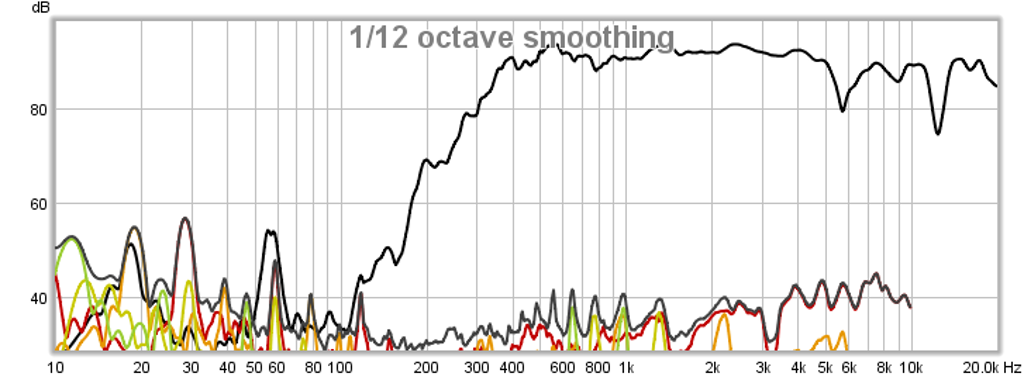
Last edited:
I'm not very familiar with the topic, sorry. I think Patrik Bateman has posted most synergy stuff out of anyone else on this forum so I'll take his word 🙂 but, I don't know what is his record. All I know it is hard to get them to play high enough, or low enough. The thread I linked seems to have wealth of info regarding the mids.
If I remember correctly it was discussed in some thread whether to put the mid at the throat but that was shot down. Maybe it became impossible to extend the high end response past 10k or so, if the tweeter wasn't on the throat? It is a compromise land, but all it takes to find the correct recipe to pull it out, or change the drivers /plan. Synergy seems to get easier to pull out with coaxial driver at the throat (mark100 has done it recently). Happy exploring, will follow how it turns out for you 🙂
edit. the patrik bateman graph you have quoted seems to be pretty good, almost 4 octave bandwidth on the mids!
If I remember correctly it was discussed in some thread whether to put the mid at the throat but that was shot down. Maybe it became impossible to extend the high end response past 10k or so, if the tweeter wasn't on the throat? It is a compromise land, but all it takes to find the correct recipe to pull it out, or change the drivers /plan. Synergy seems to get easier to pull out with coaxial driver at the throat (mark100 has done it recently). Happy exploring, will follow how it turns out for you 🙂
edit. the patrik bateman graph you have quoted seems to be pretty good, almost 4 octave bandwidth on the mids!
Last edited:
Whatever driver you put on the walls, it's going to have a dip in its response at the frequency where the sound that reflects off the apex (or the driver there) arrives to you out of phase with the sound coming directly to you from the port on the walls. You can't fool mother nature or change wavelengths. Close to the frequency where the port is a quarter wave from the apex.
Here is a study of the effect of not having a membrane at the throat to reflect, and also various additions of fiberglass stuffing around the driver basket to reduce back-cone reflections, and also more stuffing in the horn passage. The main dip at 1.76kHz was unaffected and corresponds exactly to a wall-to-wall (1/2-wave) cancellation dip for a 97mm wall-to-wall spacing at where the ports are located. The port to throat plane cancellation dip corresponds exacty to a 23mm distance from the port CL to the throat plane. With or without a tweeter membrane, there is still a discontinuity there and that dip is at 3.7KHz.
You can see that removal of the RAAL moved the 3200Hz reflection to 3700Hz - the only effect really and the 1700Hz dip had no effect, so I don't think the 1700Hz has anything to do with the tweeter reflection.
So I think perhaps the solution would be to put the mid drivers on the side walls spaced 43mm apart, this will move that 1/2-wave cancellation dip to 4khz and it would combine with the 3,7kHz to form a large natural dip for the XO frequency.
The measurement dips in frequency match precisely the physical spacings measured with a ruler. There is nothing to be gained with a better rear chamber. What needs to happen is the mid driver needs to go to the sidewall expansion. But here, will the vertical top-to-bottom secondary reflection still have an impact?

You can see that removal of the RAAL moved the 3200Hz reflection to 3700Hz - the only effect really and the 1700Hz dip had no effect, so I don't think the 1700Hz has anything to do with the tweeter reflection.
So I think perhaps the solution would be to put the mid drivers on the side walls spaced 43mm apart, this will move that 1/2-wave cancellation dip to 4khz and it would combine with the 3,7kHz to form a large natural dip for the XO frequency.
The measurement dips in frequency match precisely the physical spacings measured with a ruler. There is nothing to be gained with a better rear chamber. What needs to happen is the mid driver needs to go to the sidewall expansion. But here, will the vertical top-to-bottom secondary reflection still have an impact?
Attachments
Last edited:
Was the voice coil (or transformer) connected to anything for the w/RAAL measurements? Probably a hanging undriven ribbon by itself wouldn't present much of an impedance to pressure waves at those frequencies from the midranges. With terminals shorted it should present some impedance though.
I wonder what effect shorting/unshorting that would have on the notch positions?
The narrowing of the horn throat by itself would be expected to cause somewhat of a reflection (though not as sharp, I imagine) even without a tweeter there.
I wonder what effect shorting/unshorting that would have on the notch positions?
The narrowing of the horn throat by itself would be expected to cause somewhat of a reflection (though not as sharp, I imagine) even without a tweeter there.
If the cabinet is ~12" wide, the distance between the center point of the midrange port to the ribbon (or to whatever is behind it) looks to be a **lot** more than 24mm/1" though in that photo -- or am I seeing that wrong?
Hi Bwaslo,
Optical illusion? Here is a closeup photo of the throat and mid injection port. That's a Starrett aluminum ruler angled along the wall - you can see it is about 25mm-26mm. Taking account for the cosine(18deg) x 25mm = 23.8mm axial distance.

Maybe rectangular throats are not a good idea? Given that transverse normal modes are not easily supported by odd wall numbers like 5, perhaps throat areas need to be pentagonal? SS/Vifa/Peerless have pentagonal cut cone membranes on their popular TC9/TG9/10F/etc drivers for good reason.
the distance between the center point of the midrange port to the ribbon (or to whatever is behind it) looks to be a **lot** more than 24mm...
Optical illusion? Here is a closeup photo of the throat and mid injection port. That's a Starrett aluminum ruler angled along the wall - you can see it is about 25mm-26mm. Taking account for the cosine(18deg) x 25mm = 23.8mm axial distance.
Maybe rectangular throats are not a good idea? Given that transverse normal modes are not easily supported by odd wall numbers like 5, perhaps throat areas need to be pentagonal? SS/Vifa/Peerless have pentagonal cut cone membranes on their popular TC9/TG9/10F/etc drivers for good reason.
Attachments
Last edited:
I tried a few more things:
1. Added a foam core splitter plate at the throat to sort of isloate the two mid ports and break up the throat resonance. There is still a 10mm gap behind the RAAL mesh screen for sound to pass through. This did not change the 1.7kHz dip at all.
2. Added two sealed RS225-8 woofers in parallel on top and bottom with a sinple 10mH iron core coil. The added bass makes the sound much more pleasant to listen to.
3. Threw together a very simple XO by eye using rule of thumb values and since I have a dedicated XO dev kit with all values of inductors, capacitors, and resistors, and a bag full of Wago 211 spring clip connectors, it was easy and quick.
Listening to it sounds quite good but there is a big 500Hz to 700Hz hump that needs to be attenuated. The transietn nature / time alignment sounds pretty good though.
Crossover is all postive polarity first order electrical, on RAAL it is 2nd order electrical, 3rd order acoustic. The RS225 sealed is reaching down to 30Hz for some reason - maybe because the speaker is sort of in a corner.


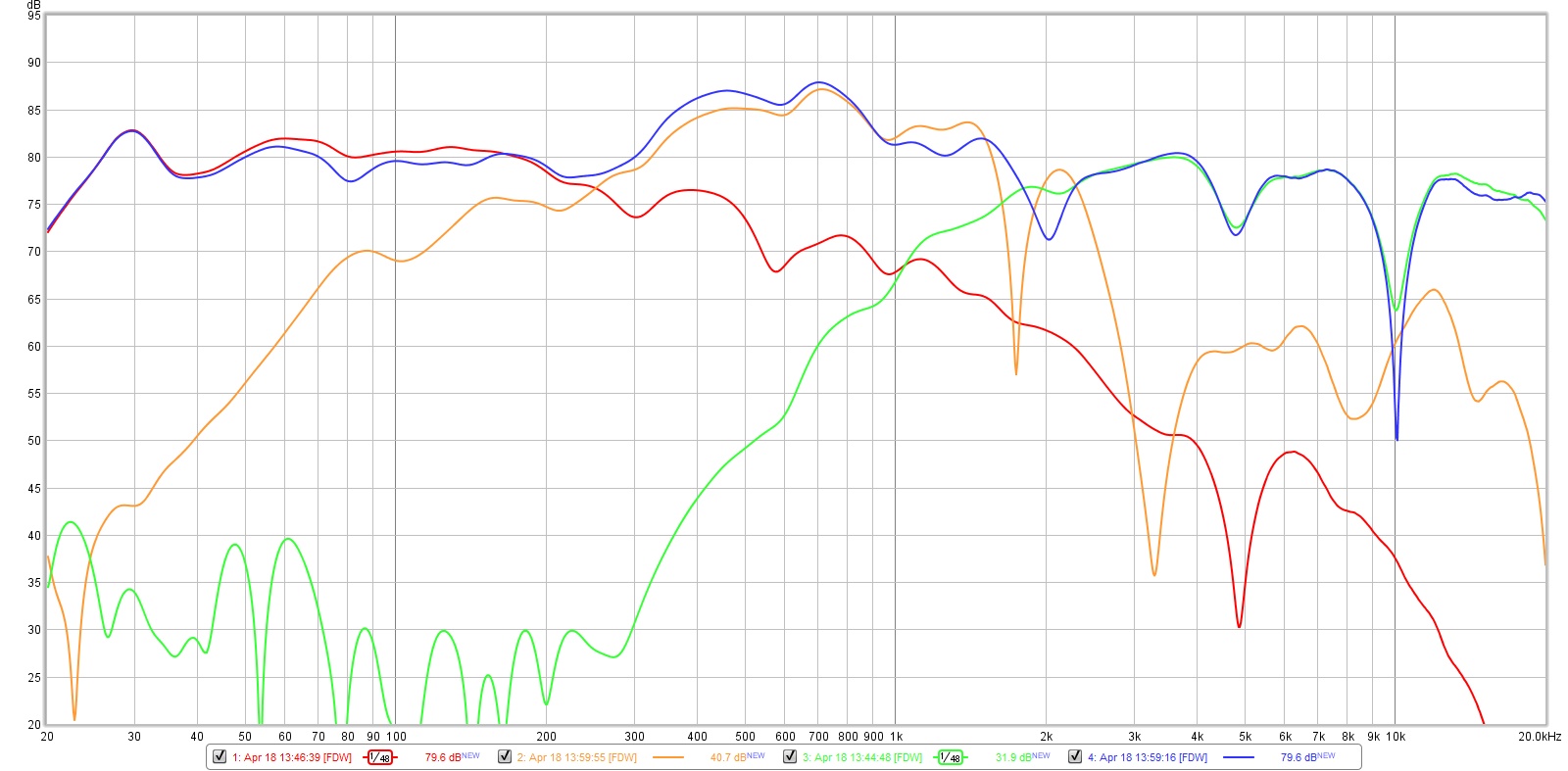
1. Added a foam core splitter plate at the throat to sort of isloate the two mid ports and break up the throat resonance. There is still a 10mm gap behind the RAAL mesh screen for sound to pass through. This did not change the 1.7kHz dip at all.
2. Added two sealed RS225-8 woofers in parallel on top and bottom with a sinple 10mH iron core coil. The added bass makes the sound much more pleasant to listen to.
3. Threw together a very simple XO by eye using rule of thumb values and since I have a dedicated XO dev kit with all values of inductors, capacitors, and resistors, and a bag full of Wago 211 spring clip connectors, it was easy and quick.
Listening to it sounds quite good but there is a big 500Hz to 700Hz hump that needs to be attenuated. The transietn nature / time alignment sounds pretty good though.
Crossover is all postive polarity first order electrical, on RAAL it is 2nd order electrical, 3rd order acoustic. The RS225 sealed is reaching down to 30Hz for some reason - maybe because the speaker is sort of in a corner.
Attachments
What if the other mid was disconnected, what happens to the dip?
Tried that already - still there.
Even with all the warts and dips, this speaker does some things well - the percussive sharpness afforded by the RAAL is there. I think the time alignment between the the drivers is not bad either. Here are some sound ciips taken with a Zoom H1n recorder about 1m away, converted to MP3 to keep size small for uploading here.
Yoy will need to unzip to play.
Yoy will need to unzip to play.
Attachments
Transient Response of Ribbons
Cool project.
While the high frequency extension and their sound qualities at those frequencies of ribbons is excellent, the one criticism I have heard about them is that they sound too polite lower in frequency - like below 7 khz. In one post you say that they have good transient response. Maybe the horn enables that? How is the transient response compared to a cone driver or compression driver?
Retsel
Cool project.
While the high frequency extension and their sound qualities at those frequencies of ribbons is excellent, the one criticism I have heard about them is that they sound too polite lower in frequency - like below 7 khz. In one post you say that they have good transient response. Maybe the horn enables that? How is the transient response compared to a cone driver or compression driver?
Retsel
In this picture it's clear you built the horn throat wider than the ribbon itself and added the foam at the sides. Why is that? Trying to learn. I'm playing with Volvotreter's Excel and the TPL...🙂
The ribbon is 20mm wide and the ribbon tweeter aperture is 43mm wide with a a sawtooth edge. The ribbon is set back from the aperture grille by about 10mm. If I made the throat only 20mm wide, there would surely be reflections from the back wall of the throat obstructing the aperture. Hence I made the throat the same width as the aperture. But maybe what is needed is a throat that immediately expands. That is not a tractrix but simple flat wall horn.
This is not the same tweeter but the aperture and ribbon difference is similar.
Raal "Original 140-15D" Ribbon Tweeter with Amorphous Core
This is not the same tweeter but the aperture and ribbon difference is similar.
Raal "Original 140-15D" Ribbon Tweeter with Amorphous Core
Cool project.
While the high frequency extension and their sound qualities at those frequencies of ribbons is excellent, the one criticism I have heard about them is that they sound too polite lower in frequency - like below 7 khz. In one post you say that they have good transient response. Maybe the horn enables that? How is the transient response compared to a cone driver or compression driver?
Retsel
This particular RAAL goes down to 1.7kHz and definitely has solid presence below 7kHz even without the horn. Actually with ribbons and AMTs I have found minimal horn gain since the membrane is not pistonic. So overall horn sensitivity is still circa 95dB, not 105dB like the mids. But the sound is directional and very nice.
- Home
- Loudspeakers
- Multi-Way
- Nano-Trynergy - a Compact Tractrix RAAL Ribbon Point-Source Horn
